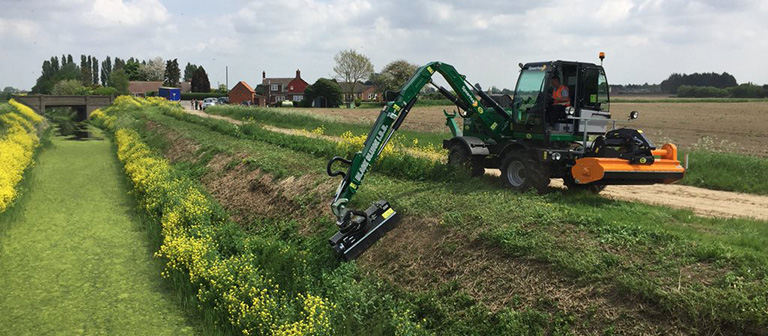ADA announces the first tranche of River Maintenance Transfer (De-maining) pilots

After much preparatory work and engagement with Internal Drainage Boards (IDBs), the Environment Agency (EA) and other partners involved, ADA is delighted to announce that Defra have given the green light to a number of pilot projects to propose to “de-main” certain sections of main river across the country. The process involves investigating the passing of river maintenance and operational activities from the EA to IDBs where there is mutual agreement, a locally generated appetite, and benefit to do so. If successful, the pilots will lead to the permanent passing of these activities to the IDBs concerned.
The catchment areas and IDBs concerned by these pilots are;
- Norfolk and Suffolk Rivers, East Anglia (Norfolk Rivers IDB, East Suffolk IDB, Broads IDB)
- Isle of Axholme, East Midlands (Isle of Axholme and North Nottinghamshire Water Level Management Board)
- South Forty Foot Drain Catchment, Lincolnshire and Northamptonshire area (Black Sluice IDB)
- Wormbrook and Allensmore Brook, Herefordshire, West Midlands (River Lugg IDB)
- River Stour Catchment, Kent & South London area (River Stour (Kent) IDB)
Defra, the Environment Agency and the Association of Drainage Authorities (ADA) will be working with the local IDBs in these Pilot areas to:
- consult the local community and other interested parties on whether they support the change in designation;
- strengthen governance by ensuring local councils have a strong voice on the boards of the IDBs; and
- strengthen local accountability through regular reporting on the work of the IDBs.
If these pilots are a success, and de-maining is supported by the local communities, Defra and the Environment Agency have indicated that they may consider the same approach for other areas.
It has been concluded locally for these sections of river that IDBs may be able to provide routine maintenance and operational services where it was becoming increasingly difficult for the Environment Agency to do so because of their necessary focus on much higher flood-risk areas and assets. Local choices have been made which mean that the IDBs which are willing to manage these stretches of river, in addition to their own Internal Drainage Districts, may (where there are no complex structures) do so at nominal additional cost and with the support of local communities and local community funding arrangements under the umbrella and scrutiny of the Regional Flood & Coastal Committees.
An important element of these pilots will be the consultation with local communities so that they are fully aware of and agree with the planned river maintenance activities to be carried out by the IDBs. It is very important that people understand more about the importance of the river works being proposed for the economic, social and environmental benefit of the local area and communities, and these projects will aim to help spread the word.
Commenting on the announcement, Innes Thomson, ADA’s Chief Executive said, “These pilots have been a long time coming and ADA warmly welcomes Defra’s decision to go ahead. Many people have worked hard to prepare the way and we all look forward to working together to make these pilots work for everyone”.
Equally pleased with the Defra’s announcement, the EA’s Director for Flood & Coastal Risk Management Strategy, Catherine Wright, added “This is a great opportunity to understand community support for the local management of low flood risk watercourses. We will be working closely with ADA, IDBs and other interested groups to make the pilots a success.”
Archive
- March 2025
- February 2025
- January 2025
- December 2024
- November 2024
- October 2024
- September 2024
- August 2024
- July 2024
- June 2024
- May 2024
- April 2024
- March 2024
- January 2024
- December 2023
- November 2023
- October 2023
- September 2023
- August 2023
- July 2023
- June 2023
- May 2023
- April 2023
- March 2023
- February 2023
- January 2023
- December 2022
- September 2022
- August 2022
- July 2022
- June 2022
- May 2022
- April 2022
- March 2022
- February 2022
- January 2022
- December 2021
- November 2021
- September 2021
- July 2021
- May 2021
- March 2021
- February 2021
- January 2021
- December 2020
- November 2020
- October 2020
- September 2020
- August 2020
- July 2020
- May 2020
- April 2020
- March 2020
- February 2020
- January 2020
- December 2019
- November 2019
- October 2019
- September 2019
- August 2019
- July 2019
- June 2019
- May 2019
- April 2019
- March 2019
- February 2019
- January 2019
- December 2018
- November 2018
- October 2018
- September 2018
- August 2018
- July 2018
- June 2018
- May 2018
- April 2018
- March 2018
- February 2018
- January 2018
- December 2017
- November 2017
- October 2017
- September 2017
- August 2017
- July 2017
- June 2017
- May 2017
- April 2017
- March 2017
- February 2017
- January 2017
- October 2016
- September 2016
- August 2016
- July 2016
- June 2016
- May 2016
- April 2016
- March 2016
- January 2016
